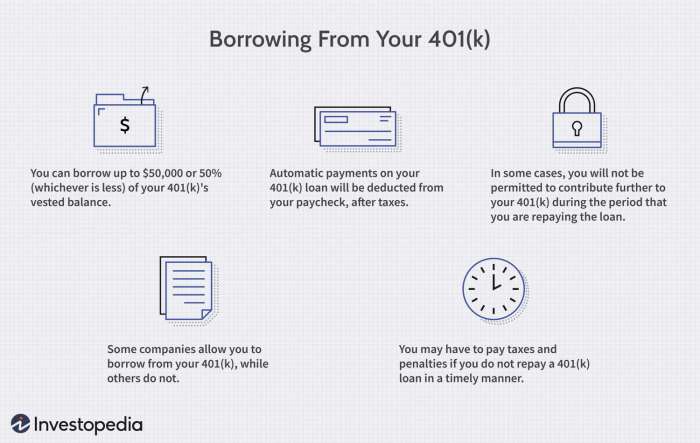
The crushing weight of student loan debt is a reality for millions, often overshadowing other crucial financial goals. Many find themselves grappling with the question: can tapping into their 401(k) for student loan repayment offer a viable solution? This guide explores the complexities of this decision, weighing the potential benefits against the significant financial implications, and ultimately helping you make an informed choice.
We’ll delve into the intricacies of 401(k) withdrawal regulations, including tax implications and penalties for early withdrawals. We’ll also examine alternative student loan repayment strategies and compare the potential returns of your 401(k) investments against the interest rates on your student loans. By understanding the long-term financial impact of each decision, you can make a plan that aligns with your overall financial well-being.
Understanding 401(k) Regulations and Withdrawal Penalties
Before considering using your 401(k) to pay off student loans, it’s crucial to understand the potential tax implications and penalties associated with early withdrawals. These regulations are designed to encourage long-term savings for retirement and withdrawing early can have significant financial consequences. This section will detail these regulations and provide examples to clarify the potential impact.
Tax Implications of Early 401(k) Withdrawals
Early withdrawals from a 401(k) are generally subject to both income tax and a 10% early withdrawal penalty. This means that not only will you have to pay taxes on the amount you withdraw at your current tax bracket, but you’ll also incur an additional 10% penalty. For example, if you withdraw $10,000 and are in a 22% tax bracket, you would owe $2,200 in income tax ($10,000 x 0.22) plus $1,000 in penalty ($10,000 x 0.10), for a total of $3,200. This significantly reduces the amount you actually receive to alleviate your student loan debt.
Penalties for Withdrawing Funds Before Age 59 1/2
The 10% early withdrawal penalty applies to most withdrawals made before age 59 1/2. There are exceptions, as detailed below, but it’s important to be aware of this significant cost. This penalty is in addition to the regular income tax you’ll owe on the withdrawn amount. The penalty serves as a disincentive to deplete retirement savings prematurely.
Exceptions to Early Withdrawal Penalties
While penalties are common, several situations allow for early 401(k) withdrawals without the 10% penalty. These exceptions are typically designed to address financial hardship or specific life events.
Examples of Permissible Early Withdrawals Without Penalty
Several situations allow for penalty-free early withdrawals. These include:
- Death or Disability: Withdrawals made due to the death or disability of the account holder are generally exempt from the 10% penalty.
- Birth or Adoption Expenses: Qualified birth or adoption expenses may allow for penalty-free withdrawals, up to certain limits.
- Qualified Higher Education Expenses: Withdrawals for qualified higher education expenses may be exempt from the penalty, subject to specific rules and limitations.
- First-Time Homebuyer Expenses: Up to $10,000 in withdrawals for a first-time home purchase may be penalty-free.
- Unreimbursed Medical Expenses: Expenses exceeding 7.5% of your adjusted gross income may allow for penalty-free withdrawals.
Withdrawal Penalty Scenarios
The following table summarizes different withdrawal penalty scenarios based on age and reason for withdrawal. Note that this is a simplified representation and individual circumstances may vary. Consult a financial advisor for personalized guidance.
| Age | Reason for Withdrawal | 10% Penalty? | Income Tax? |
|---|---|---|---|
| 45 | Unreimbursed Medical Expenses (exceeding 7.5% AGI) | No | Yes |
| 50 | Purchase of a new car | Yes | Yes |
| 60 | Death of account holder | No | Yes (for beneficiary) |
| 30 | First-time homebuyer (up to $10,000) | No | Yes |
| 40 | General living expenses | Yes | Yes |
Student Loan Repayment Strategies
Navigating student loan debt can feel overwhelming, but understanding various repayment options and their implications is crucial for financial well-being. This section explores alternative strategies to help you manage your student loans effectively, considering their advantages and disadvantages in comparison to using your 401(k) for repayment.
Income-Driven Repayment Plans
Income-driven repayment (IDR) plans adjust your monthly student loan payments based on your income and family size. Several IDR plans exist, each with different eligibility requirements and payment calculation methods. These plans can significantly lower monthly payments, making them more manageable for borrowers with lower incomes. However, they often extend the repayment period, leading to potentially higher overall interest paid. For example, an individual earning $40,000 annually might qualify for a significantly reduced monthly payment under an IDR plan compared to a standard repayment plan, but the total repayment time might increase from 10 years to 20 or even 25 years.
Student Loan Refinancing
Refinancing involves replacing your existing student loans with a new loan from a private lender, often at a lower interest rate. This can save you money on interest over the life of the loan. However, refinancing may mean losing federal student loan benefits such as income-driven repayment plans or loan forgiveness programs. Careful consideration of the potential trade-offs is essential before refinancing. For instance, a borrower with high-interest federal loans might find refinancing advantageous, especially if they can secure a significantly lower interest rate and don’t rely on federal loan forgiveness programs. Conversely, a borrower who anticipates needing an IDR plan in the future might choose to avoid refinancing.
Interest Rate Comparison: Student Loans vs. 401(k) Investments
Comparing the interest rates on your student loans to the potential return on your 401(k) investments is critical. Student loan interest rates vary depending on the loan type and lender, but they are typically fixed. 401(k) investment returns, however, are variable and depend on market performance. Historically, the stock market has offered higher returns than student loan interest rates over the long term, although it carries greater risk. For example, a student loan with a 7% interest rate might seem high compared to a 401(k) with an average annual return of 8% over the past decade. However, a market downturn could significantly reduce the 401(k)’s return, making the student loan option seemingly more attractive in the short term.
Decision-Making Flowchart
The following flowchart illustrates the decision-making process for choosing between paying off student loans and leaving funds in a 401(k):
[Start] –> [Assess Student Loan Interest Rate] –> [Is the interest rate significantly higher than the potential 401(k) return?] –> [Yes] –> [Consider paying down high-interest loans first] –> [No] –> [Assess risk tolerance and long-term financial goals] –> [High risk tolerance and long-term focus?] –> [Yes] –> [Prioritize 401(k) contributions] –> [No] –> [Consider a balanced approach: partial loan repayment and 401(k) contributions] –> [End]
This flowchart represents a simplified decision-making process. Individual circumstances and risk tolerance will significantly influence the final decision.
Financial Implications and Long-Term Planning

Withdrawing from your 401(k) to pay off student loans carries significant long-term financial consequences that extend far beyond the immediate relief of debt. Understanding these implications is crucial for making an informed decision that aligns with your overall financial goals. The decision requires careful consideration of the trade-off between immediate debt reduction and the potential for substantial future financial growth.
The primary concern is the detrimental impact on your retirement savings. Withdrawing funds from your 401(k) before retirement means forfeiting years of potential compound growth. This is because 401(k) accounts benefit from the power of compounding, where investment earnings generate further earnings over time. Early withdrawals not only reduce your principal but also diminish the future value of your retirement nest egg. For example, withdrawing $20,000 today to pay off student loans might mean losing out on $50,000 or more by retirement age, depending on investment returns and the time horizon. This loss represents a significant reduction in your potential retirement income.
Retirement Savings Impact
Early 401(k) withdrawals also often incur significant tax penalties and fees. Depending on your age, you may face a 10% early withdrawal penalty, in addition to paying income taxes on the withdrawn amount. This effectively increases the cost of using your 401(k) to pay off student loans. Furthermore, the lost investment growth compounds over time, resulting in a much larger loss than the initial withdrawal amount. Consider a scenario where a young professional withdraws $10,000, incurring a $1,000 penalty plus taxes. This immediate loss is compounded by the missed opportunity to earn interest and returns on that $10,000 over several decades. The ultimate financial impact could be considerably higher than the initial outlay.
Benefits of Maintaining 401(k) Contributions
Maintaining consistent 401(k) contributions, even while managing student loan debt, offers several significant long-term advantages. The power of compounding is a key factor. Even small, regular contributions can accumulate substantially over time due to the effects of interest and investment growth. Moreover, many employers offer matching contributions to employee 401(k) accounts, essentially providing free money. Forgoing these matching contributions represents a significant opportunity cost. By prioritizing 401(k) contributions, you secure a foundation for a financially secure retirement, reducing the reliance on Social Security and other potential sources of income later in life. This financial security can provide peace of mind and reduce stress associated with potential financial instability in retirement.
Factors to Consider When Deciding
Before deciding whether to use your 401(k) to pay off student loans, carefully weigh the following factors:
- Your age: Younger individuals have a longer time horizon to recover from the loss of investment growth, making this option potentially less damaging. Older individuals nearing retirement face a more significant risk.
- The amount of student loan debt: If the debt is relatively small, the potential long-term impact on retirement savings might outweigh the benefits of immediate repayment.
- Your current income and expenses: Can you manage both student loan payments and 401(k) contributions without undue financial strain?
- Your employer’s matching contributions: Are you forfeiting free money by not contributing to your 401(k)?
- Your overall financial goals: How important is a comfortable retirement compared to being debt-free sooner?
- The interest rate on your student loans: High-interest loans might justify a more aggressive repayment strategy, even if it involves tapping into retirement savings. However, always carefully consider the long-term consequences.
Seeking Professional Financial Advice

Navigating the complex decision of using your 401(k) to pay off student loans requires careful consideration of various financial factors. A qualified financial advisor can provide invaluable guidance, helping you weigh the potential benefits against the long-term consequences. Their expertise ensures you make an informed decision aligned with your overall financial goals.
A financial advisor plays a crucial role in helping you understand the implications of withdrawing from your 401(k) for student loan repayment. They can analyze your current financial situation, considering factors like your income, debt, savings, and retirement goals. This comprehensive assessment allows them to provide personalized advice tailored to your specific circumstances. They can also explain the tax implications and potential penalties associated with early 401(k) withdrawals, ensuring you’re fully aware of the financial ramifications before making a decision.
Questions to Ask a Financial Advisor
Before making any decisions, it’s essential to gather all the necessary information. A productive conversation with your financial advisor should cover several key aspects. This allows you to make an informed decision based on a clear understanding of your situation.
- What are the potential tax penalties and fees associated with withdrawing from my 401(k) before retirement age?
- How will a 401(k) withdrawal impact my long-term retirement savings and investment growth?
- What are the alternative strategies for managing my student loan debt, such as refinancing or income-driven repayment plans?
- Considering my current financial situation and future goals, what is the optimal strategy for managing both my student loan debt and retirement savings?
- What is the projected impact on my net worth and credit score if I choose to withdraw from my 401(k)?
Creating a Personalized Financial Plan
A financial advisor can create a comprehensive financial plan that considers all your assets and liabilities, including your 401(k) and student loans. This plan will Artikel different scenarios, showing the potential consequences of various decisions. For example, they can model the impact of withdrawing a specific amount from your 401(k) on your retirement savings, comparing it to alternative strategies like refinancing your student loans or extending your repayment period. The plan will also include a detailed analysis of your current financial situation, highlighting areas for improvement and strategies for achieving your financial goals. This customized approach ensures that your financial decisions are strategically aligned with your long-term objectives.
Sample Client-Advisor Dialogue
Client: I’m considering withdrawing from my 401(k) to pay off my student loans. Is this a good idea?
Advisor: Let’s explore that. While it might seem like a quick solution, it’s crucial to consider the long-term implications. We need to analyze your current 401(k) balance, your student loan debt, and your retirement goals. Early withdrawals usually incur penalties and taxes, significantly impacting your future retirement savings. We need to carefully weigh these factors.
Client: What are my other options?
Advisor: We can explore refinancing your student loans to secure a lower interest rate, potentially reducing your monthly payments. We can also look at income-driven repayment plans that adjust your payments based on your income. Additionally, we can create a budget to help you allocate more funds towards your student loan repayment while still maintaining your savings and retirement contributions.
Client: So, you’re suggesting we look at all the options before making a decision?
Advisor: Absolutely. My role is to help you make an informed decision that aligns with your overall financial goals. We’ll analyze all possibilities, including the potential impact of a 401(k) withdrawal, and create a personalized plan to help you manage your debt and secure your financial future.
Illustrative Scenarios
To further clarify the complexities of using 401(k) funds to pay off student loans, let’s examine contrasting scenarios where this decision could be either beneficial or detrimental. These examples illustrate the importance of careful consideration and professional financial guidance before making such a significant decision.
Scenario 1: Financially Sound Decision
This scenario depicts a situation where withdrawing from a 401(k) to pay off high-interest student loan debt could be a justifiable financial move. Consider Sarah, a 30-year-old software engineer with a $100,000 annual income. She has $50,000 in high-interest private student loans (8% APR) and $20,000 in her 401(k). Her retirement goal is to retire comfortably at 65 with a nest egg of $1 million. Sarah’s current investment portfolio is relatively diversified and performing well. Her high-interest student loan payments are significantly impacting her ability to save aggressively for retirement and other financial goals. By strategically withdrawing a portion of her 401(k) (perhaps $10,000 to $15,000, carefully considering the tax implications) to pay down a significant portion of her high-interest debt, she could save substantially on interest payments over the long term. This strategy could ultimately allow her to increase her retirement savings more rapidly by freeing up significant cash flow from monthly loan payments. The potential long-term savings on interest would outweigh the penalties and lost investment growth from the 401(k) withdrawal.
Scenario 2: Financially Detrimental Decision
This scenario highlights the potential negative consequences of prematurely withdrawing from a 401(k) to pay off student loans. Let’s consider Mark, a 25-year-old teacher with a $50,000 annual income. He has $40,000 in federal student loans (5% APR) and $15,000 in his 401(k). His retirement goal is also to retire comfortably at 65, aiming for $750,000. Mark’s 401(k) contributions are relatively modest, and he is just beginning to build his retirement savings. If Mark withdraws from his 401(k) to pay off his student loans, he would incur significant tax penalties and fees, severely impacting his already limited retirement savings. The relatively low interest rate on his federal student loans makes the potential return on investment in his 401(k) far more valuable in the long run. The lost potential for compounded growth over the next 40 years far outweighs the benefit of accelerated student loan repayment. This decision would likely hinder his ability to achieve his retirement goals.
End of Discussion

Ultimately, the decision of whether to use your 401(k) to pay off student loans is deeply personal and depends heavily on your individual financial circumstances. While the allure of quickly eliminating debt is strong, the long-term consequences of jeopardizing your retirement savings must be carefully considered. This guide has provided a framework for evaluating your options; however, seeking personalized advice from a qualified financial advisor is crucial before making such a significant financial move. Remember, a well-informed decision today can significantly impact your financial future.
Essential Questionnaire
What are the tax consequences of withdrawing from a 401k before age 59 1/2?
You’ll typically face income tax on the withdrawn amount, plus a 10% early withdrawal penalty unless an exception applies (e.g., hardship withdrawal).
Can I withdraw only a portion of my 401k for student loan repayment?
Yes, you can typically withdraw a specific amount, but remember that any withdrawal will be subject to taxes and potential penalties.
What constitutes a “hardship withdrawal” from a 401k?
Hardship withdrawals are allowed under specific circumstances, such as medical expenses or foreclosure prevention. The exact definition varies by plan, so check your plan documents.
Are there any other ways to reduce my student loan debt besides using my 401k?
Yes, consider income-driven repayment plans, refinancing, or exploring options like student loan forgiveness programs.
